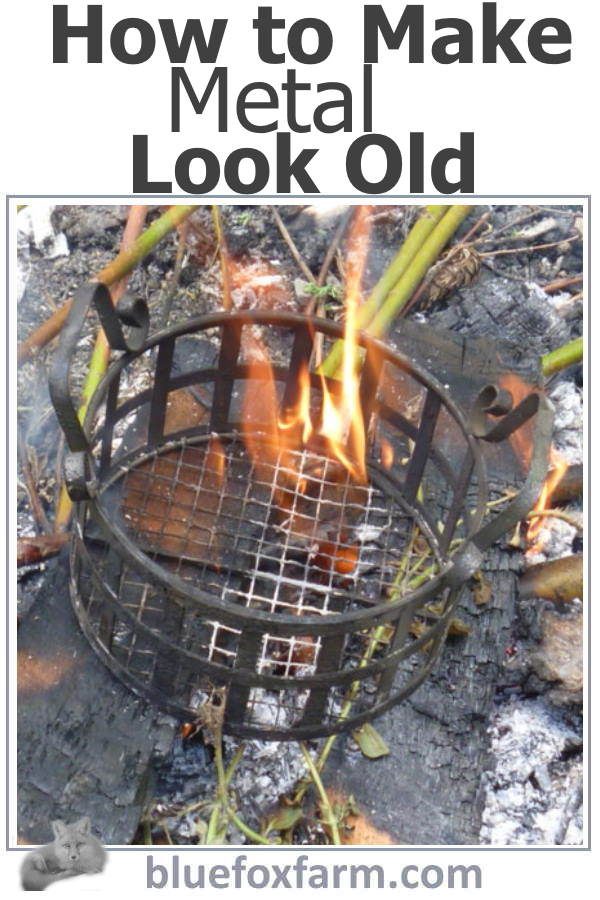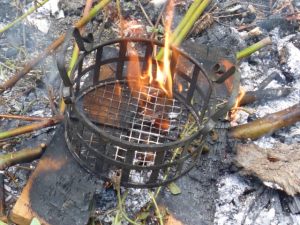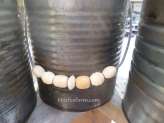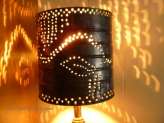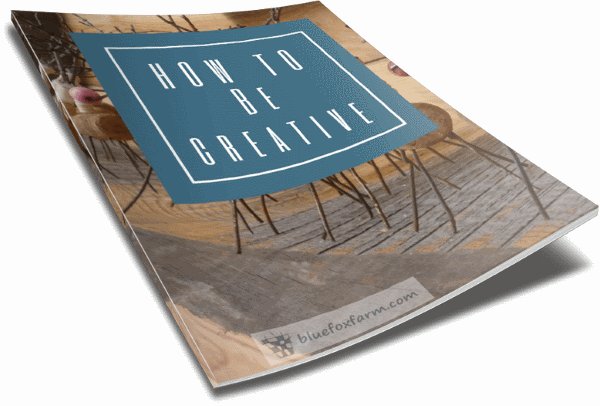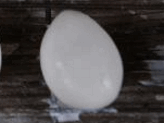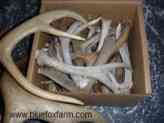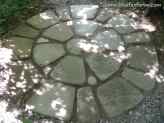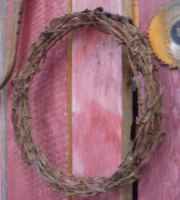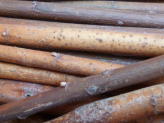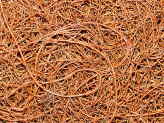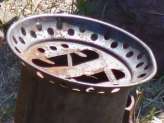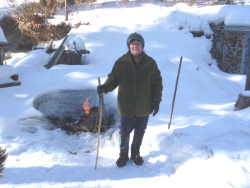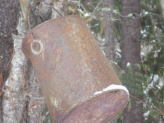How to Make Metal Look Old
Ways to Create Verdigris, Rust, Patina and Distressing
Jacki Cammidge is a participant in the Amazon Services LLC
Associates Program, an affiliate advertising program designed to
provide a means for sites to earn advertising fees by advertising and
linking to amazon.com. Other links on this site may lead to other affiliates that I'm involved with, at no extra cost to you.
Tarnish, verdigris and patina are all different ways that make metal (and other materials) look old.
In some cases, the oxidization process
takes years, in others, months. But you can get this process in only a few hours.
Making metal look old and patina'd, also known as "distressing" or "antiquing," can be an interesting and fun project. The method to apply will depend on the type of metal you are working with, but here are some general steps you can follow:
1. Clean the Metal: Inspect the metal for any dust, grime, or rust. Use a soft cloth or brush to clean it thoroughly.
2. Sand the Metal: If the metal is smooth, roughen it a bit using sandpaper. This step allows the paint and other solutions you'll apply to stick better.
3. Apply Primer: Use a metal primer to prepare the surface. Spray the primer evenly and let it dry completely.
4. Apply Base Coat: Once the primer dries, apply a base coat of paint that matches the final color you want. This color will peek through the final layer of paint, giving the impression of wear and tear.
5. Apply Antiquing Solution: Various solutions can be used to give a patina effect, like vinegar, saltwater, or specialized products you can find at a hardware store. If using vinegar, for instance, you can create a mixture of vinegar, salt, and hydrogen peroxide. Spray it on the metal and let it stand for a while.
6. Scrub: After the solution has dried, scrub off areas using a wire brush or steel wool to reveal the base layer. This makes the object look worn and naturally aged.
7. Seal the Patina: If you are satisfied with how distressed your object looks, seal the finish with a clear coat to protect it.
Remember to always work in a well-ventilated area and use gloves and eye protection. Be patient as the process takes time for the metal to react to the solutions and achieve the aged look you desire.
Check out my methods here, and get started on rusticating your metal objects.
How to Age Metal
- Tarnishing refers mostly to silver, especially sterling.
Old silver eventually obtains a muted opaque look, generally with darker areas where the wearing isn’t removing the tarnish.
Really good silver will tarnish beautifully; as the years pass, the patina will only improve. This is not something you can effectively fake, although soaking the silver in vinegar is a place to start.
- Verdigris is the greenish blue that occurs on brass and copper, as well as bronze, the admixture of the two metals.
Used for statues commemorating heroes, as roof panels for some very famous buildings, and as the metal used for the Statue of Liberty, the verdigris that shows after years of weathering is very different from the original gleaming colour of copper kettles and brasses used on horse tack.

Verdigris is almost impossible to fake. If ever the verdigris is removed from a roof for instance, or copper rain chains, it can never be matched.
You can make copper wire oxidize enough to get some verdigris by spraying it with a strong vinegar solution, and after several sprayings it will start to change colour.
Use pickling vinegar, for a safe method of making verdigris. See more about verdigris here.
Muriatic acid will also work, but requires more care as it is very strong. It's used as a rust remover in commercial applications, and can be purchased at vehicle maintenance supply stores.
Copper will also naturally go green in sea air, as I've found here in my new place near the ocean.
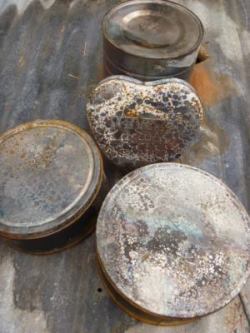
- Patina is a catch all phrase to mean the look of age or weathering that occurs to all items.
It can be the lichen on old buildings and bridges, unchanged for centuries, or the look of a well loved piece of antique furniture.
Once removed by renovation, the patina will never be the same.
Coin collectors know this all too well – after the first time someone brings them a valuable seldom struck piece of ancient currency that they 'cleaned up' – removing the patina purposely is never a good idea, as it removes the worth and value of the piece too.
- Rusting is another way to make metal look old, and fortunately, it is possible to fake.
Only old farm equipment and cars left out in the baking sun for decades can beat the faux rusting process that I use.
Simply throwing cans and metal objects, even shiny new barbed wire into the fire to remove any paint or other manufacturing finishes, and then leaving the item out in the rain and weather to finish the process can give you a beautiful rusty patina.
Want it to happen faster?
After burning the finish off, spray or dip the item in a bath of bleach, vinegar or salt water. That will get the oxidization process started.
When it's the right amount of rustiness, rinse it off, and let it age out in the weather.
Snow is the best weathering agent around, but rain works too.
Use this technique for cans to use in tin can planters and tin can lanterns. See the magical effect of this punched tin lamp shade.
I've had a lot of fun with making tin can buckets too. The addition of a few beads makes all the difference to the finished project.
You can speed up the process by spraying with bleach which will make the item rust almost instantly. Rinse the bleach off when it’s done its job.
You need to take care when handling these items, as the rust will come off on your hands.
Once you finish making the craft you can lightly rub it with some kind of oil to give it the ability to withstand wear.
Try out these ways of making metal look old, and create some patina on your rustic crafts.
Are you a pyromaniac?
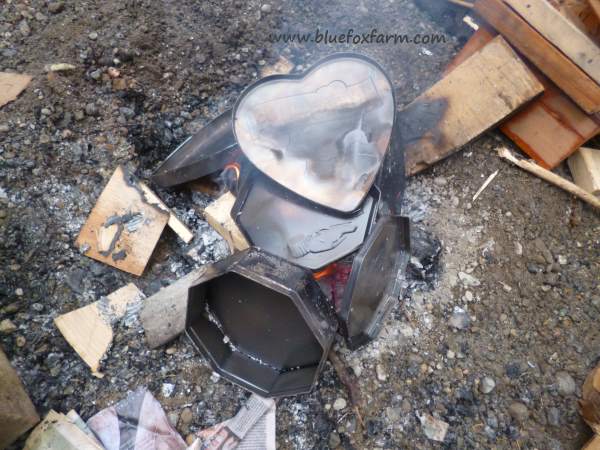
If you're like me and a bit of a pyromaniac, you'll enjoy the fun activity of throwing your candy and cookie tins on the bonfire - I recommend allotting a full morning or afternoon to this because you'll need plenty of time to move them around to burn off all the paint; don't let them get too hot, or they'll warp.
Put them somewhere to put them to cool off and let the rain do its work; ideally somewhere to give them time to rust over the winter.
Make sure they can drain, because if water freezes in them it will break the seams.
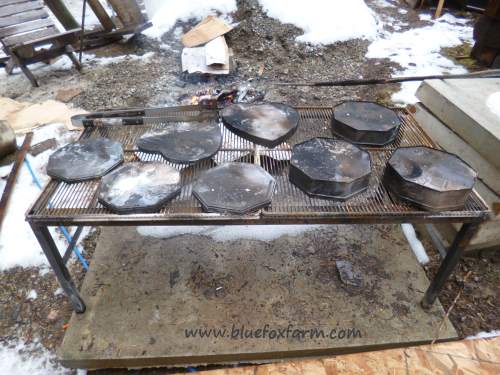
The rusting process can take a week or more to develop the full look.
This circular saw blade was already slightly rusty, but putting it in the bonfire, then on top of the rain barrel to get watered by the rain was the crowning glory.
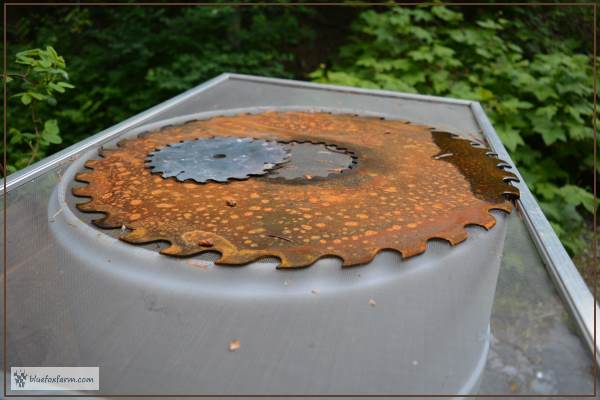
How to Set Up Your Burning Facility;
There's nothing fancy about setting up your area to burn metal things - a small fire area, built with safety in mind (not close to any building, keep a charged fire hose or full watering can handy, a shovel to stop any embers from escaping and build the firepit on mineral soil) even a pit a few feet across will serve.
I have a barbecue grill attached to two ground rods (long metal pieces) to cook soil on, or even hot dogs.
My go-to implement is a three tined pitchfork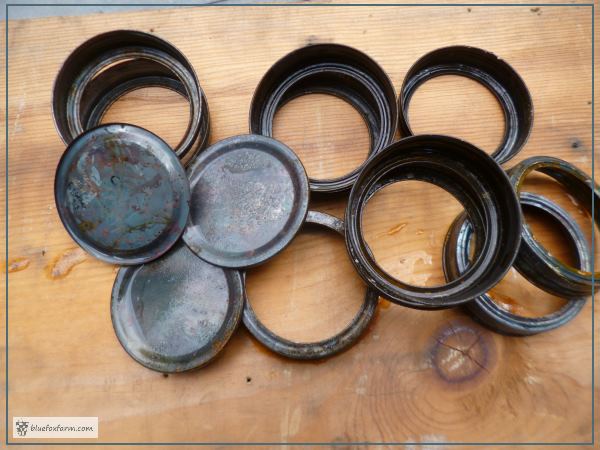
The flat discs from the lids are burned using a specially designed basket made out of hardware cloth and some wire.
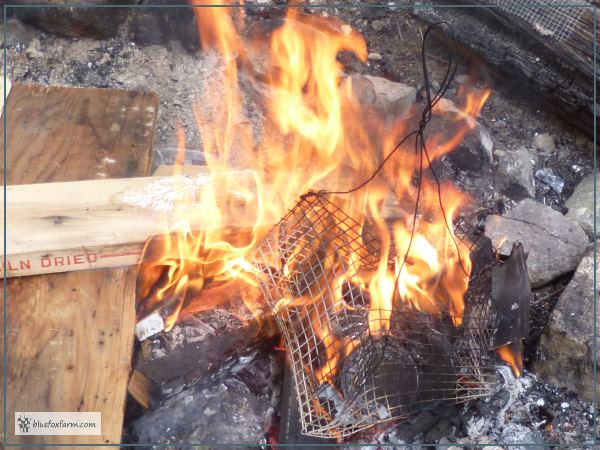
I have a special section in my woodshed for wood to burn for this type of project.
This is where I keep pieces of junk lumber, old crates, rotting logs that are too punky for indoor burning, and demolition salvage. It doesn't matter what you use to burn the metal bits as long as it's dry.
Do not burn treated lumber, it has toxic elements that are poisonous to breathe when the item is burned.
What kinds of metal can you age?
What kinds of metal can you age?
The best kinds are iron based - not stainless steel or aluminum, which tend to not change at all, or just go dull.
Sometimes this is the look you desire, in which case, burn away!
Can I use bleach to rust metal?
Can I use bleach to rust metal?
Bleach will certainly start the rusting process; use care with it, as it can rot fabric and be a dangerous environmental pollutant.
Learn what it takes to be creative - we all have the gene but how do we develop it? Get the free guide!
Fill in the form below for your copy;
(Don't be disappointed - use an email address that will accept the free download - some .aol email addresses won't.
If you don't see your download within a few minutes, try again with another email address - sorry for the bother.)
